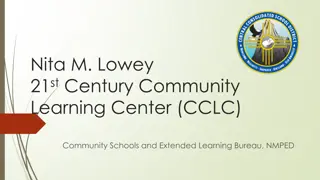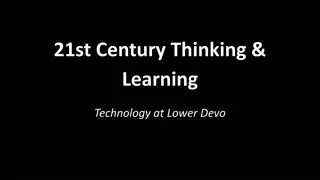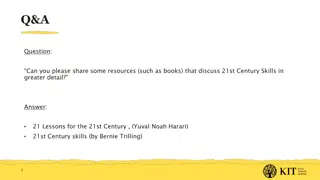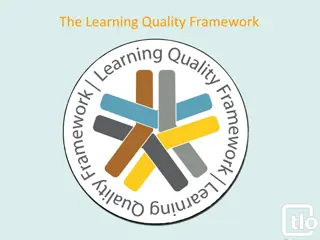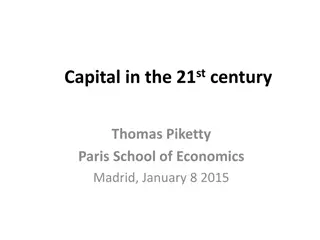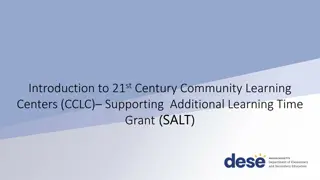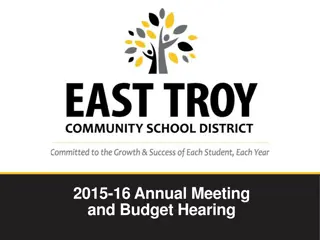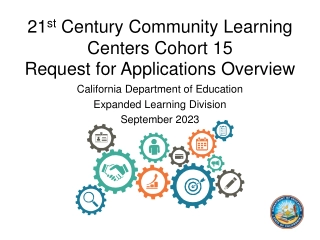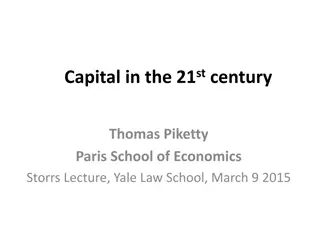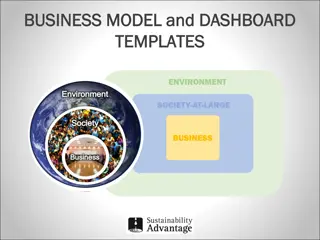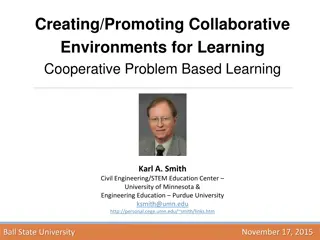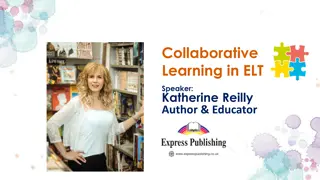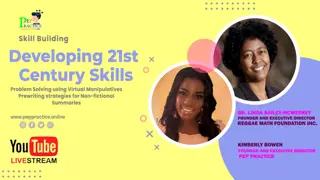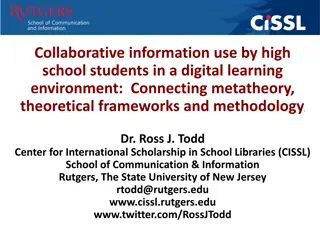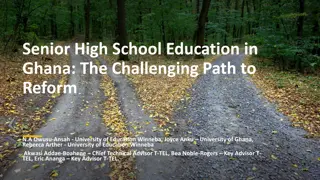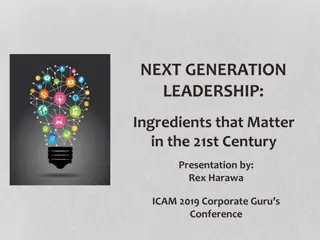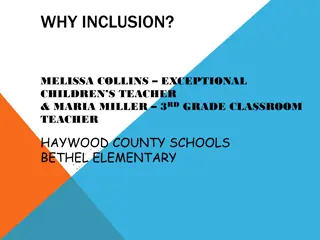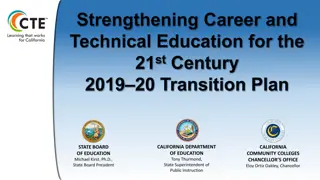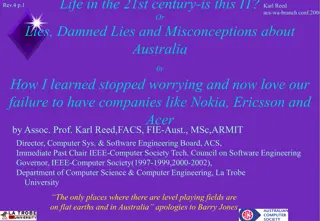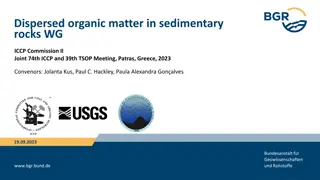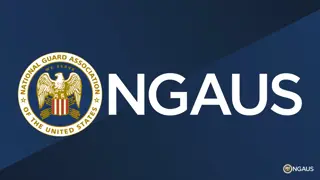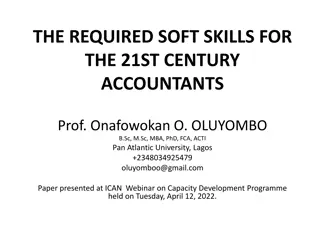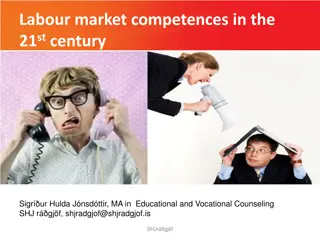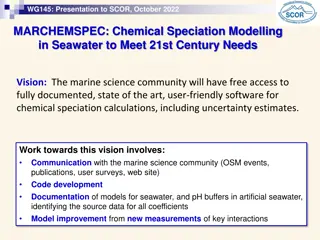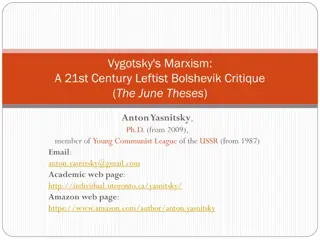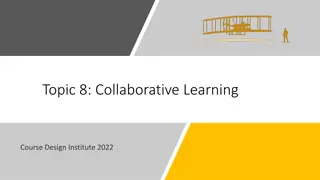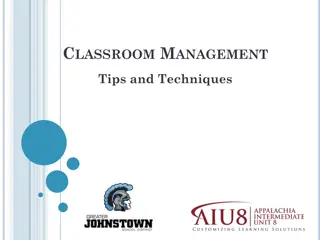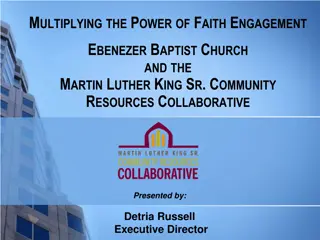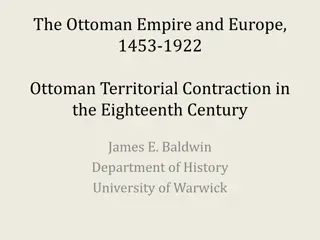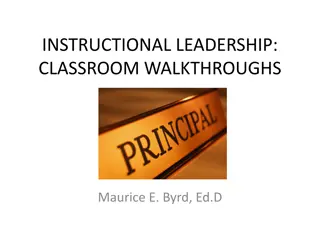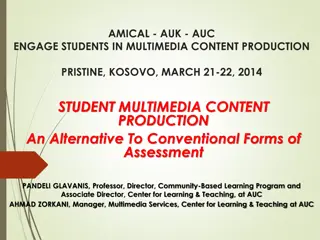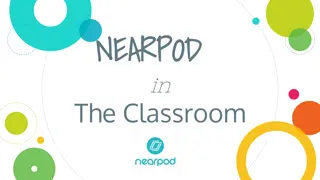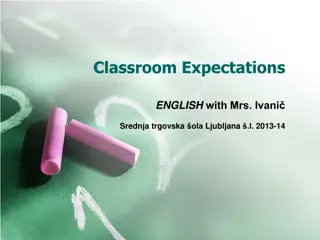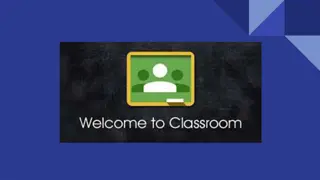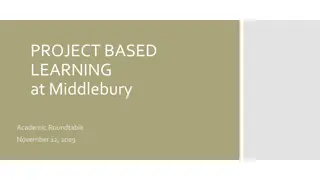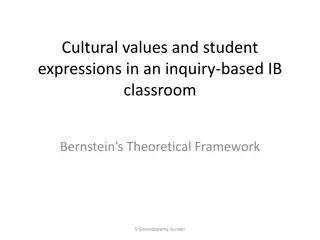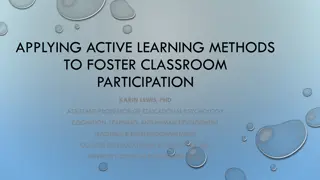Promoting Collaborative and Problem-Based Learning in the 21st Century Classroom
Cooperative learning involves joint goals, mutual rewards, and shared resources among group members, fostering positive attitudes, higher-order thinking, and increased knowledge retention. Engaging students in collaborative strategies enhances social skills, self-esteem, and intrinsic motivation, creating a learner-centered environment for diverse learners.
- Collaborative learning
- Problem-based learning
- Cooperative learning
- Student engagement
- 21st century classroom
Download Presentation

Please find below an Image/Link to download the presentation.
The content on the website is provided AS IS for your information and personal use only. It may not be sold, licensed, or shared on other websites without obtaining consent from the author. Download presentation by click this link. If you encounter any issues during the download, it is possible that the publisher has removed the file from their server.
E N D
Presentation Transcript
COLLABORATIVE LEARNING PROMOTING COLLABORATIVE AND PROBLEM-BASED LEARNING IN THE 21st CENTURY CLASSROOM Dr. Susan Belgrad California State University, Northridge
A Definition and a Distinction Cooperative learning is the presence of joint goals, mutual rewards, shared resources and complementary roles among members of a learning group Competitive learning conversely is the presence of a goal or reward that only one or a few group member(s) could achieve be outperforming the others.
GETTING STARTED WHY COOPERATIVE LEARNING HOW TO GET STARTED HOW TO ASSURE OPTIMAL LEARNING OF ALL STUDENTS
Why Do We Need to Engage Students in 21stCENTURY Learning Strategies? THEY HELP TO: Develop better attitudes toward school Build better attitudes toward teachers Promote more on-task behavior Develop students higher order thinking Develop students perspective taking Increase retention of new knowledge, skills, ideas Resulting in higher achievement of diverse students
Why Do We Need to Engage Students in Cooperative Learning Strategies? Develop students social skills Result in more positive heterogeneous relationships Increase diverse learners self-esteem Provide greater social support throughout the K-12 learning environment
Why Do We Need to Engage Students in Cooperative Learning Strategies? Create a learner-centered climate leading to positive psychological adjustment Lead to greater intrinsic motivation for all learners
P.M.I. ON COOP LEARNING INTERESTING PLUS MINUS
HOW WE LEARN 5% OF WHAT WE HEAR (lecture) 10% OF WHAT WE READ 20% OF WHAT WE BOTH SEE AND HEAR 30% OF WHAT IS DEMONSTRATED 50% OF WHAT IS DISCUSSED WITH OTHERS 75% OF WHAT WE EXPERIENCE PERSONALLY 90% OF WHAT WE TEACH
Old vs. New Standards of Learning OLD STANDARDS 21ST CENTURY STANDARDS Learning by doing in a collaborative classroom Hands-on/Physical materials Technology integration amplifies learning Inquire, explore, justify thinking Alternative approaches to problem solving Respect for others and flexibility in thinking. Teach by telling Paper-Pencil tasks Competitive environment Minimal technology-not allowed Don t think just do (only one right way) Must follow the rules Look for clues to the right solution
Old vs. New Standards of Learning OLD STANDARDS NEW STANDARDS Topic Isolation Teacher talks Integrated topics Students discuss/develop ideas Activity between students/ group responsibility and individual responsibility; learner interdependence Individual responsibility for learning
AGREE/DISAGREE I believe that a teacher should: agree disagree 1. Use cooperative learning at least 40% of class time. 2.Integrate technology 3.Expect learners to create rules--justify thinking in learning
AGREE/DISAGREE I believe that a teacher should: agree disagree 4.Promote learners search for alternative approaches 5.Use more hands-on tasks 6.Promote learner responsibility
CHARACTERISTICS OF INTELLIGENT BEHAVIOR PERSISTENCE DECREASING IMPULSIVITY EMPATHIC LISTENING FLEXIBILITY IN THINKING METACOGNITIVE AWARENESS CHECKING FOR ACCURACY
CHARACTERISTICS OF INTELLIGENT BEHAVIOR QUESTIONING PROBLEM POSING DRAWING ON PAST KNOWLEDGE APPLYING TO NEW SITUATIONS PRECISION OF LANGUAGE AND THOUGHT USING ALL THE SENSES
CHARACTERISTICS OF INTELLIGENT BEHAVIOR INGENUITY, ORIGINALITY, INSIGHTFULNESS & CREATIVITY INQUISITIVENESS AND CURIOSITY ENJOYMENT OF PROBLEM SOLVING
HOW TO PROMOTE COOPERATIVE LEARNING THE GOOSE STORY
THE GOOSE STORY Next fall when you see geese heading south for the winter flying along in a V formation, you might be interested in knowing why they fly that way. It has been learned that as each bird flaps its wings, it creates an uplift for the bird immediately following. By flying in a V formation, the whole flock adds at least 71% greater flying range than if each bird flew on its own.
People who share common direction and sense of community can get where they are traveling on the thrust of one another.Whenever a goose falls out of formation, it suddenly feels a drag and resistance of trying to go it alone, and quickly gets into formation to take advantage of the lifting power of the bird immediately in front. If we have as much sense as a goose, we will stay in formation with those who are headed the same way we are going.
When the lead goose gets tired, he rotates back in the wing and another goose flies to point. It pays to take turns doing hard jobs. The geese honk from behind to encourage those up front to keep up their speed.. An encouraging word goes a long way Finally, when a goose gets sick, or is wounded by a gun shot and falls out, two geese fall out of formation and follow him down to help and protect him.
They stay with him until he is either able to fly or until he is dead, and they launch out on their own or with another formation to catch up with the group. If we have the sense of a goose we will stand by each other like that. Author Unknown
HOW COOP GROUPS DIFFER TRADITIONAL GROUPS One goal/task learned at a time Groups are done when product/task is done Social skills are taken as a given One leader gets main role COOPERATIVE GROUPS Higher order thinking is woven into every lesson Groups continue to work together Social skills are taught Roles are shared and mixed
HOW COOP GROUPS DIFFER TRADITIONAL GROUPS Group is assessed without looking at individual efforts Teacher grades product COOPERATIVE GROUPS Individual contribution to group goal is assessed Groups look back and process interactions and group work Students with different characteristics are mixed/matched Homogenous groups created
HOW COOP GROUPS DIFFER TRADITIONAL GROUPS Students only responsible for themselves Each student relies on him/herself COOPERATIVE GROUPS Members share responsibility for the group Students rely on each other
TRIPLE T-CHART ATTENTIVE LISTENING LOOKS LIKE SOUNDS LIKE FEELS LIKE
TRIPLE T-CHART TEAM BUILDING LOOKS LIKE SOUNDS LIKE FEELS LIKE
SOCIAL SKILLS WE NEED TO TEACH IN COOPERATIVE LEARNING FORMATION OF GROUPS SUPPORT COMMUNICATION CONFLICT RESOLUTION
FORMATION OF GROUPS FORM GROUPS QUIETLY SIT EYEBALL TO EYEBALL MAKE EYE CONTACT USE EACH OTHER S NAMES SHARE MATERIALS FOLLOW ROLE ASSIGNMENTS
SUPPORT CHECK FOR UNDERSTANDING OFFER YOUR HELP ASK YOUR GROUP FIRST FOR HELP IF YOU DON T UNDERSTAND ENCOURAGE EACH OTHER ENERGIZE THE GROUP DISAGREE WITH THE IDEA- NOT THE PERSON
COMMUNICATION USE 6-INCH VOICES TAKE TURNS MAKE SURE EVERYONE SPEAKS WAIT UNTIL SPEAKER IS FINISHED BEFORE YOU SPEAK
CONFLICT RESOLUTION DISAGREE WITH THE IDEA- NOT THE PERSON RESPECT THE OPINIONS OF OTHERS THINK FOR YOURSELF
CONFLICT RESOLUTION EXPLORE DIFFERENT POINTS OF VIEW NEGOTIATE AND/OR COMPROMISE REACH CONSENSUS
COOPERATIVE GROUP ACTIVITIES FOR TODAY SHARING P.M.I. STATEMENTS SHARING THE AGREE/DISAGREE PORTMANTEAU ATTENTIVE LISTENING SOCIAL SKILL LESSON
PORTMANTEAU ASSIGN GROUP ROLES DISTRIBUTE PORTMANTEAU WORD LISTS ENCOURAGER TEACHES 3 WORDS TO GROUP CHECKER CHECKS WORRIER TEACHES 3 WORDS CHECKER CHECKS ETC....
PORTMANTEAU ORAL GROUP QUIZ TEAMS PROCESS FACILITATOR PROCESSES
PLANNING A COOPERATIVE GROUP ACTIVITY FORMATION OF GROUPS ROLE ASSIGNMENTS TASK TIME LIMITS SOCIAL SKILL TO BE ASSESSED INTELLIGENT BEHAVIOR TO BE ASSESSED PROCESSING ENCOURAGING ENERGIZER
TYPES OF COOPERATIVE GROUPS INFORMAL TASK GROUPS FORMAL TASK GROUPS BASE GROUPS
PHASES OF SOCIAL SKILLS INTRODUCTION FORMING NORMING CONFORMING STORMING PERFORMING RE-FORMING
COOPERATIVE GROUP FORMING SKILLS MOVE INTO A GROUP MOVE OUT OF A GROUP ONE PERSON TALKS AT A TIME STAY WITH THE GROUP CONTROL VOLUME OF TALK (3 6 , 12 VOICES PRACTICE ALL RULES
Q & A SESSION WHAT S LEFT? WHAT TO DO WITH THE KID WHO?
CONCLUSION GOOD LUCK!!


